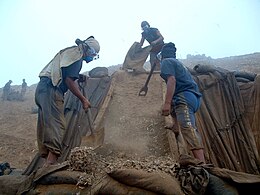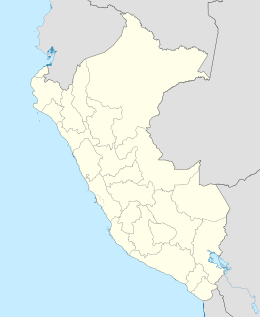Guañape Islands
This article does not cite any sources. (April 2021) |
Islas Guañape (Spanish) | |
|---|---|
 Workers collecting guano at Guañape Norte Island. | |
 Guañape Islands | |
| Geography | |
| Location | Pacific Ocean |
| Coordinates | 8°32′41″S 78°57′49″W / 8.54472°S 78.96361°WCoordinates: 8°32′41″S 78°57′49″W / 8.54472°S 78.96361°W |
| Major islands |
|
| Area | 0.6273 km2 (0.2422 sq mi) |
| Highest elevation | 143 m (469 ft) |
| Administration | |
| Region | La Libertad |
| Additional information | |
| Time zone |
|
The Guañape Islands are an island group off the coast of northern Peru. It consists of four islands: Isla Guañape Norte, Isla Guañape Sur, Islotes Cantores and Islotes Los Leones.
the southern coast of Peru, lie some groups of ods-the Chinchaes, the Bellastras, the Lobos, the abre, and the Guanape Islands. These islands have me breeding grounds for a very large variety of its that feed on marine creatures. The word guano means bird droppings, Over a period of thousands of years, a 100-150 feet thick layer of guano has cumulated. The primary producers of guano are white-breasted cormorants, grey pelicans, and white-headed gannets. It is estimated that around a million these birds can live on one island and produce over 1,000 tonnes of guano annual
Background of Peru
Due to the unique weather conditions prevalent along the coast of Peru, the Peruvian guano is considered to be the best guano for farming. Due to the flow of the cold Humboldt Current along Peru's coast, the cold water prevents rainfall from occurring here. The lack of rain on these islands and the tropical heat cause the accumulated bird droppings to get baked naturally in the dry atmosphere. This helps to prevent nitrates from evaporating and retain their fertility. Another reason for the guano being fertile is that it originates from fish-eating birds. Due to relative isolation from natural predators, guano-producing birds, like the white-breast cormorants and gray pelican, have increased in number.
FACT BITE
Long before Columbus, the Incas highly valued guano as a fertilizer. it was so important to their culture that the Incan government divided the guano-bearing islands between the various provinces and dictated when and where it could be harvested. Incan law also provided that killing or disrupting the nesting birds that produced guano was punishable by death.
Exploitation of Guano
It was in 1804 that some people visited the islands and then returned to Europe with some guano It was here that they understood its usefulness as an excellent fertilizer. In the next 45 years, Peruvians turned it into a major export product.
Economic Importance of Guano
Guano is a highly sought-after commodity in the international market because it is a very rich fertilizer. Peruvian economy depends on guano export. In the 20th century, artificial fertilizers replaced guano to a large extent affecting the Peruvian economy. Another threat is ocean warming and the El effect which has disrupted the unique ecosystem of the area. It has reduced the number of fish, affecting the bird population, and causing a reduction in guano accumulation, and the economy of Peru.
Conservation of Guano
The Guano Islands belong to Peru and provide excellent natural manure. The Peruvian government has taken steps to conserve the guano reserves
and prevent their over-exploitation. To maintain the supply of this form of manure, the government of Peru ensures that the islands and the birds, such as pelicans and cormorants, and the gannets are well fed and cared for.
References[]
Further reading[]
- Ray, R.C. (1890). The West Coast of South America: Comprising Magellan Strait, Tierra Del Fuego, and the Outlying Islands. U.S. Government Printing Office. p. 275.
- Pacific islands of Peru
- Landforms of La Libertad Region
- La Libertad Region geography stubs
